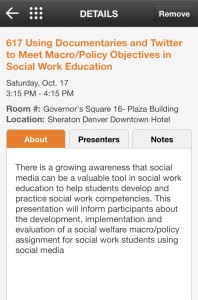#APM2015 Using Documentaries and Twitter to Meet Macro/Policy Objectives in Social Work Education

 Today, Dr. Jimmy Young and I are presenting at the 61st Annual Program Meeting of the Council on Social Work Education about our social media assignment using a documentary movie and Twitter. There is a growing awareness that social media can be a valuable tool in social work education to help students develop and practice social work competencies. This presentation will inform participants about the development, implementation and evaluation of a social welfare macro/policy assignment for social work students using social media. In our session, we will The learning objectives for this session include:
Today, Dr. Jimmy Young and I are presenting at the 61st Annual Program Meeting of the Council on Social Work Education about our social media assignment using a documentary movie and Twitter. There is a growing awareness that social media can be a valuable tool in social work education to help students develop and practice social work competencies. This presentation will inform participants about the development, implementation and evaluation of a social welfare macro/policy assignment for social work students using social media. In our session, we will The learning objectives for this session include:
1. Understand how the social media platform Twitter can be incorporated into assignments for social work policy and macro courses.
2. Demonstrate how social work educators can assess attainment of competency among social work students using a social media assignment paired with a Rubric for evaluation of the assignment’s learning outcomes.
3. Appreciate the role of professional collaboration in the development, implementation and evaluation of social media-based assignments.
Here is a link to the Prezi that we will show during the presentation.
Finally, here is the abstract for our presentation:
Social media includes applications, digital technologies, and mobile devices that utilize the Internet in a manner to create an interactive dialogue among organizations, communities, and individuals (Richardson, 2006). More specifically, social media are defined as an array of digital technologies that allow for the creation and exchange of user generated content (Kaplan & Haenlein, 2010; Kanter & Fine, 2010). Irrespective of the variety of terms and definitions, the role of the user as an active participant of interaction with others is paramount when describing social media (Kilpelainen, Paykkonen, & Sankala, 2011). There is a growing awareness that social work practitioners, students and educators need to be adept at using social media and information communication technology as part of their practice and interaction with clients and organizations of all sizes (Coe Regan & Freddolino, 2008; Getz, 2012; National Association of Social Workers [NASW], 2005; Quinn & Fitch, 2014). However, technology in social work education has been integrated sporadically with varying degrees of success, and the literature suggests social work educators need to increase their digital competencies or digital literacies while carefully considering how and why to integrate technology into their courses and curricula (Hitchcock & Battista, 2013; Quinn & Fitch, 2014; Straub, 2009; Young, 2014). By doing so, educators can play a pivotal role in helping students to increase their own digital literacies, and ultimately apply this knowledge to their own learning and subsequent practice.
The overarching research question for the study is whether Twitter is a useful tool to meet learning objectives in social work education. Assignments and classroom tasks using Twitter help students learn about technology tools and resources available to communicate and interact with other professionals, and to stay informed about social work practice over time (Greenhow & Gleason, 2012). This presentation will inform participants about the development, implementation and evaluation of a social welfare macro/policy assignment for students using the microblogging platform, Twitter and a documentary film. The assignment involves social work students from multiple universities spread across different parts of the country using Twitter to participate in a live chat about a macro/policy issue highlighted in the film, and is embedded as part of a policy and or macro-practice course. Students write two reflective papers based on the film and the experience of the live Twitter chat. Through the assignment, students actively engage in competency-based practice behaviors connected to professional behavior, policy practice and critical thinking while also increasing digital literacies (CSWE, 2008). Specifically, students are able to use critical thinking augmented by creativity and curiosity to convey their thoughts and reactions to the issue being highlighted, and students understand that policy affects service delivery. Students are able to engage in policy practice through this assignment by collaborating with others to advocate for policies that advance social well-being.
Student competency attainment is assessed through a rubric designed specifically for the assignment and implemented across multiple classrooms. Rubrics have been increasingly used to assess and promote student learning (Gezie, Khaja, Chang, Adamek, & Johnsen, 2012; Stevens, Levi, & Walvoord, 2012). Additional data that is used includes an archive of the live Twitter chat and a survey given to chat participants at the end of the event to assess the use of Twitter and how it can be used to facilitate student learning and improve the assignment for future classes. Results suggest that students overwhelmingly enjoyed the live Twitter chat, even those who despise the platform, and that many students were surprised that they could have civil conversations with others over the Internet. Additional themes will be discussed and the presenters will also share their experiences in designing and executing the assignment along with data demonstrating how the assignment’s rubric assessed student achievement of social work competencies. Lessons learned from the project will be shared and implications for the implicit curriculum will be reviewed.
Social media allows users to move become more than simply passive consumers of information as they learn to be informed content creators (Gammon & White, 2011) who interact with and expand their community. Social work educators can utilize social media to move beyond the classroom and enhance knowledge, skills, and learning to respond to contexts that shape social work practice and advance social and economic justice (Hitchcock & Battista, 2013). In short, social media extends the social presence of the classroom beyond the boundaries of the campus community and allows students to develop professional social work identities in accordance with the competencies, values, and ethics of the social work profession.
References (500 words):
Coe Regan, J. A., & Freddolino, P. P. (2008). Integrating technology in the social work curriculum. Alexandria, VA: Council on Social Work Education.
Council on Social Work Education. (2008). Educational Policy and Accreditation Standards. Washington, DC: Author.
Gammon, M. A., & White, J. (2011). (Social) media literacy: Challenges and opportunities for higher education. Cutting-Edge Technologies in Higher Education, 1, 329–345.
Getz, L. (2012). Mobile App Technology for Social Workers. Social Work Today, 12 (3), 8 -10.
Gezie, A., Khaja, K., Chang, V. N., Adamek, M. E., & Johnsen, M. B. (2012). Rubrics as a Tool for Learning and Assessment: What do Baccalaureate Students Think? Journal of Teaching in Social Work, 32(4), 421-437.
Greenhow, C. & Gleason, B. (2012). Twitteracy: Tweeting as a new literary practice. The Educational Forum, 76(4), 464-478.
Hitchcock, L. I., & Battista, A. (2013). Social Media for Professional Practice: Integrating Twitter with Social Work Pedagogy. The Journal of Baccalaureate Social Work, 18(special issue), 33-45.
Kanter, B., & Fine, A. H. (2010). The networked nonprofit: Connecting with social media to drive change. San Francisco, CA: Jossey-Bass.
Kaplan, A. M., & Haenlein, M. (2010). Users of the world, unite! The challenges and opportunities of Social Media. Business Horizons, 53, 59-68.
Kilpelainen, A., Paykkonen, K., & Sankala, J. (2011). The use of social media to improve social work education in remote areas. Journal of Technology in Human Services, 29(1), 1-12.
NASW (National Association of Social Workers)/ASWB (Association of Social Work Boards). (2005). NASW & ASWB Standards for technology and social work practice. Retrieved on July 30, 2012 from http://www.socialworkers.org/practice/standards/NASWTechnologyStandards.pdf.
Quinn, A., & Fitch, D. (2014). A Conceptual Framework for Contextualizing Information Technology Competencies. Journal of Technology in Human Services, 32(1/2), 133-148.
Richardson, W. H. (2006). Blogs, Wikis, Podcasts, and Other Powerful Web Tools for Classrooms. Thousand Oaks, CA: Corwin Press.
Stevens, D. D., Levi, A. J., & Walvoord, B. E. (2012). Introduction to Rubrics: An Assessment Tool to Save Grading Time, Convey Effective Feedback, and Promote Student Learning (2nd edition.). Sterling, VA: Stylus Publishing.
Straub, E. T. (2009). Understanding Technology Adoption: Theory and Future Directions for Informal Learning. Review of Educational Research, 79(2), 625–649.
Young, J. (2014). iPolicy: Exploring and Evaluating the use of iPads in a Social Welfare Policy Course. Journal of Technology in Human Services, 32(1-2), 39-53.
How to cite this post:
Hitchcock, L., Young, J. (2015, October 17).#APM2015 Using Documentaries and Twitter to Meet Macro/Policy Objectives in Social Work Education[Blog Post]. Retrieved from https://laureliversonhitchcock.org/2015/10/17/apm2015-using-documentaries-and-twitter-to-meet-macropolicy-objectives-in-social-work-education/.


